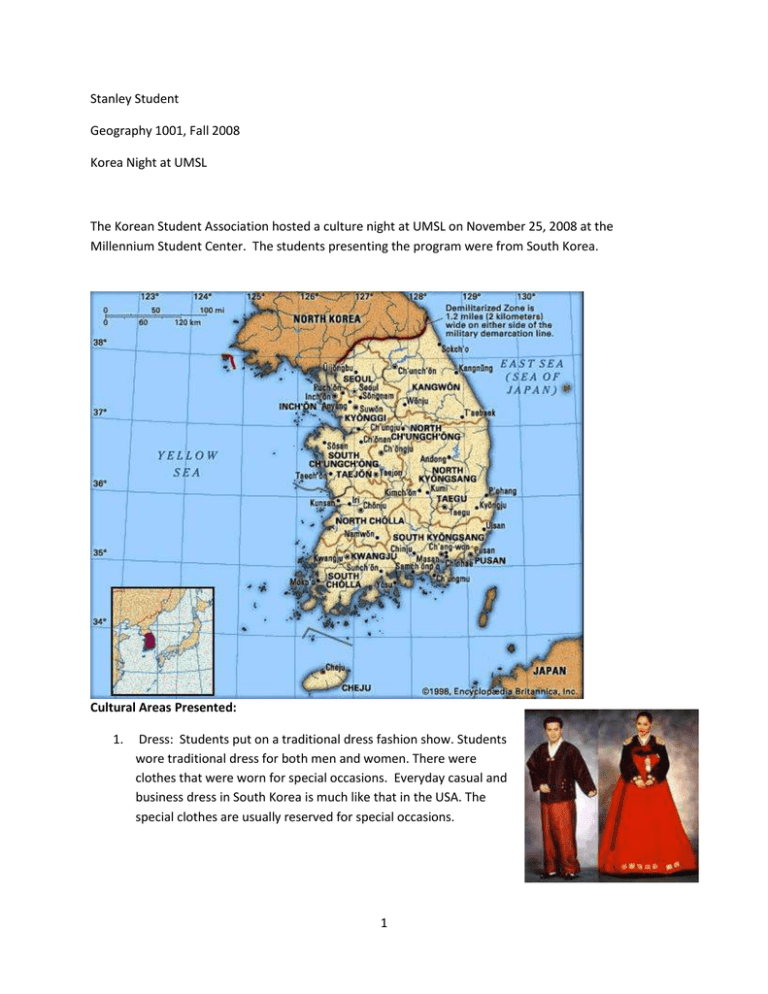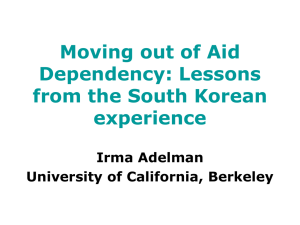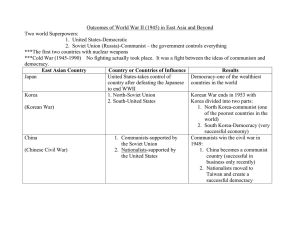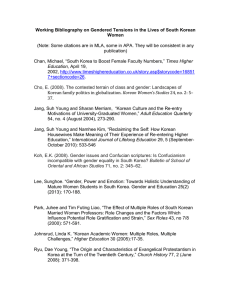Stanley Student Geography 1001, Fall 2008 Korea Night at UMSL
advertisement

Stanley Student Geography 1001, Fall 2008 Korea Night at UMSL The Korean Student Association hosted a culture night at UMSL on November 25, 2008 at the Millennium Student Center. The students presenting the program were from South Korea. Cultural Areas Presented: 1. Dress: Students put on a traditional dress fashion show. Students wore traditional dress for both men and women. There were clothes that were worn for special occasions. Everyday casual and business dress in South Korea is much like that in the USA. The special clothes are usually reserved for special occasions. 1 2. There were several kinds of South Korean food available for us to sample. I particularly enjoyed the Korean noodles and the kimchi. Kimchi is a special kind of pickled cabbage. Figure 2 Korean Noodles Figure 1 Kimchi 3. Korean music. Music was played with a traditional Korean instrument. A gayageum is a traditional Korean zither-like string instrument, with 12 strings, although more recently variants have been constructed with 21 or other numbers of strings. The sound was interesting and very different from the European-culture based music familiar to most Am eriucans. 4. Korean Dance: Several young ladies in traditional dress performed a very stylized kind of traditional dance accompanied by traditional music. 2 The three most interesting things I learned: 1. Students showed a great deal of pride in their history and culture. They were able to embrace the “modern” or “Western” cultural elements while maintaining pride in their heritage. 2. I was surprised by the number of products that are made by Korean corporations: Honda, Kia, Samsung, POSCO (steel manufacture), LG (electronics & appliances), FILA (fashions), Daewoo, and many others I’ve never heard of. I was also surprised to find out that South Korea is the world’s largest ship builder. 3. I was impressed that a distinct culture developed in Korea in spite of the periods when it was ruled by either China or Japan. The Biggest Difference I noticed between South Korea and the United States: South Koreans show more respect for elder family members and elder citizens. Families maintain contact among three or even four generations – for centuries, the extended family was the primary social unit in South Korea. Regular contact with several generations provides a sense of “rootedness” for young persons as they mature. What could the U.S. learn from South Korea? I don’t know how to accomplish it, but the U.S.A. could benefit from regaining families that maintain multigenerational contacts. So many American families are shallowly rooted transplants where they live. For many American older couples, most, if not all, of their children and grandchildren live in other cities – they’re separated by hundreds or even thousands of miles. 3






